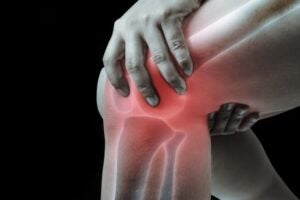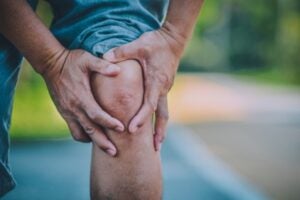Knee Pain Treatment in Pikesville, MD
How Knees Develop Pain and How That Affects Your Hips
Knee pain is a commonly seen condition that can alter how one lives, affecting their ability to walk, exercise, or perform simple movements without severe discomfort. At Fidel Integrated Medical Solutions, our team understands the importance and urgency of knee pain relief and provides various treatment options to help our patients get back to feeling their best.
The Structure of the Knee
Known as the largest joint in the human body, the knee comprises four main sections, the bones, ligaments, cartilage, and tendons.

Bones
The knee joint is made up of the connection of three bones, including:
- The femur (thigh bone)
- The tibia (shin bone)
- The kneecap (patella)
Ligaments
The ligaments in the knee are used to connect the different bones. The knee has four ligaments, including:
- Two collateral ligaments on each side of the knee allow sideways knee motions.
- Two cruciate ligaments within the knee joint cross over one another in an x formation that enables forward and backward motions.

Cartilage
There are two different types of cartilage within the knee, including:
- Articular cartilage blankets the thigh and shin bone and the back side of the kneecap to enable the bones to glide across each other when the leg is straightened out or bent.
- Meniscal cartilage includes two wedge-shaped parts that serve as shock absorbers for the shin and thigh bones.
Tendons
The tendons serve as connectors, allowing the bones to connect to the muscles within the knee.

Could Your Knee Pain be Arthritis?
Knee pain can be caused by osteoarthritis, which can occur at any age but is typically seen in patients over 50. Knee pain from osteoarthritis may happen gradually, suddenly, or return in waves. This type of knee pain is associated with a painful, stiff sensation that may feel more severe towards the end of the day.
The Causes of Hip and Knee Pain
There are many types of knee pain, from inner knee pain to pain behind the knee, knee pain when bending, and much more. Hip and knee pain may be the result of a range of different conditions and factors, including:
- sports-related injuries
- Sudden impact injuries
- Tendonitis
- Osgood-Schlatter’s disease
- Patellofemoral pain syndrome
- Over-use injuries
- Osteoarthritis
Knee Pain Location Chart
When determining what type of knee pain, you are navigating, it’s important to consider the many different types of knee pain one may experience, including:
- Inside knee pain
- Lateral knee pain
- Knee joint point
- Knee pain when squatting
- Knee pain when bending
- Pain on the outside of the knee
- Back of knee pain
How the Hip and Knee Are Related
The hip and knee are attached to the same kinetic chain. This group of weight-bearing joints operates in unison to allow proper bodily motion. When something is wrong with one portion of the kinetic chain, it becomes out of balance leading to stress and deterioration of the other components.
When to Seek Professional Knee Pain Management
The following signs indicate it’s time to seek professional knee pain management, including:
- Severe pain
- Pain and swelling of the knee
- No improvement in pain or mobility after several weeks
- Limited or no ability to move the knee
- Severe pain when putting weight on the knee
- Your knee clicks, locks, or gives out
Knee Pain Treatment
Depending on the root cause of the knee pain and the severity of the symptoms, there are several different knee pain treatments available, including:
- Prescription pain relievers
- Anti-inflammatories
- Muscle relaxants
- Injectable treatments
- Physiotherapy
- Surgery
Managing Knee Pain
In some cases, knee pain can be alleviated without medical intervention. There are many stretches for knee pain you may try to alleviate knee joint pain and other types of discomfort. You may also try a knee brace for pain management before pursuing more intensive treatment.
Diagnosing Knee Pain
To diagnose knee pain, a doctor will perform a physical examination of the knee and ask about the symptoms associated with the knee pain. They may also send the patient for further testing or scans to solidify an accurate diagnosis to develop the most effective pain management treatment.
Get Knee Pain Relief Today
If you’re struggling with knee pain limiting you from moving or engaging in activities as you once did, Fidel Integrated Medical Solutions is here to help. Contact our friendly team of medical professionals today to learn more about knee pain and knee pain relief treatments.
